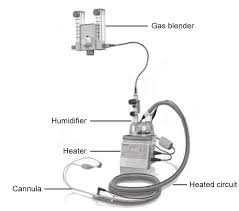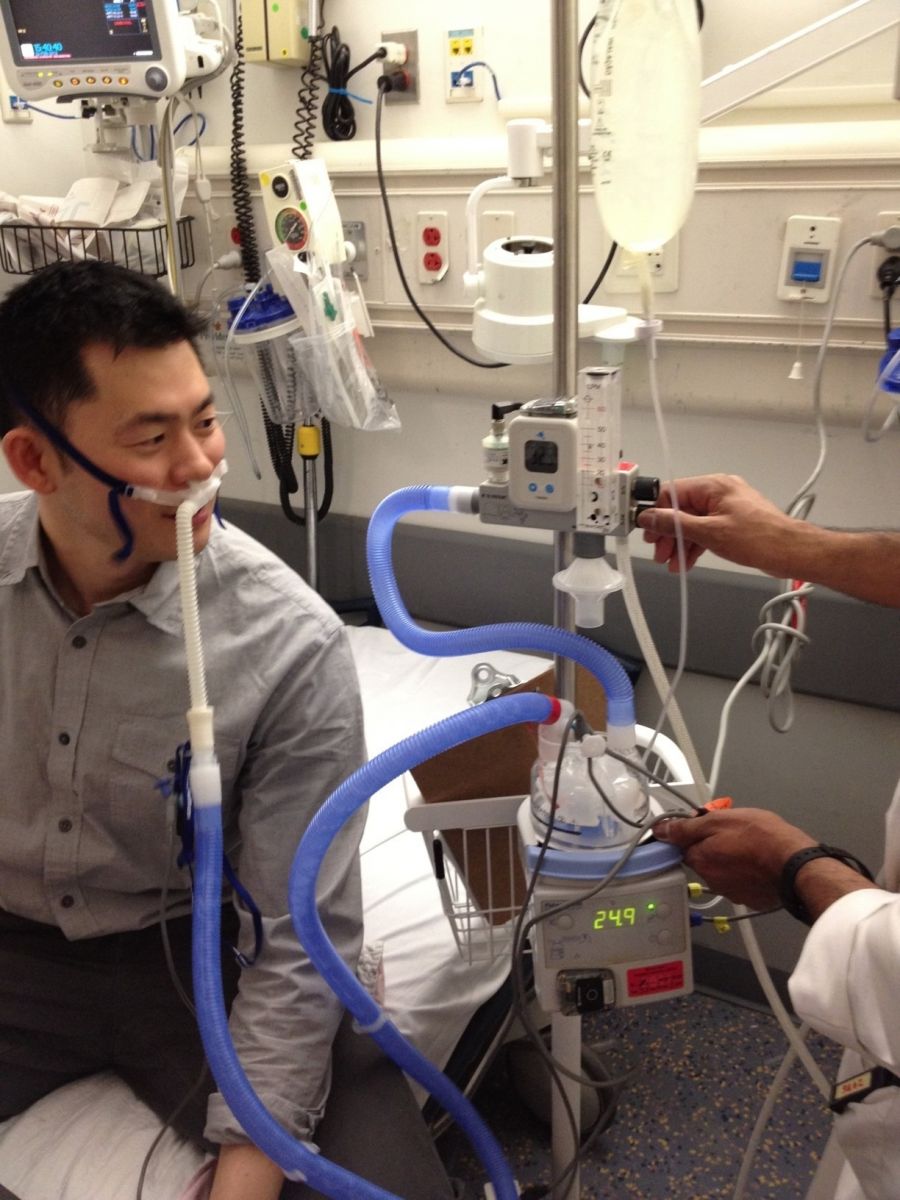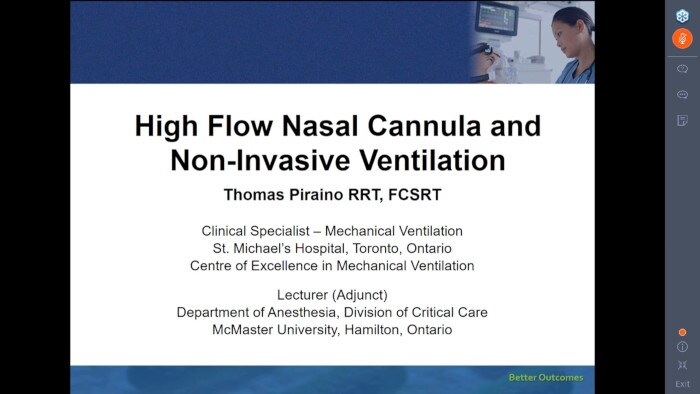heated high flow oxygen vs bipap
Ad Free Shipping - Lowest Prices - Shop Machines Cleaning and Accessories. The objective was to assess the efficacy and safety of HHHFNC compared.

China High Flow Oxygen Therapy Without Air Compressor Nasal Cannula Hfnc China Hfnc High Flow Oxygen
CPAP BiPAP and APAP are used to treat obstructive sleep apnea one of the leading sleep disorders in the country.

. The oxygen concentrators pulse-flow. The gas mixture containing up to 100 of oxygen is routed to a heated humidifier delivering gas conditioned at 37 C and completely saturated with water relative humidity. Gases are delivered to the patient via a simple interface nasal prongs or cannulae which are configured to provide high flow and limit water condensation.
High Flow systems available today can generate flow rates anywhere between 2-120 litresminute much like ventilators. HFNC is suggested to reduce the upper airway dead space and resistance 1011. FindingsIn this randomized clinical noninferiority trial of 316 infants the use of heated humidified high-flow nasal cannula was noninferior to nCPAPBiPAP with regard to the primary outcome.
Listing a study does not mean it has been evaluated by. HFNC is more comfortable and studies have shown that using HFNC may be a better alternative than using a face mask. Oxygen therapy on the other hand is used to treat COPD and other chronic respiratory diseases.
Comparison of High-flow Oxygen vs. HFNC like CPAP is a high flow system and is able to generate a positive end expiratory pressure but unlike CPAP it does not have a valve 9. However under certain conditions such as COPD-OSA overlap syndrome your doctor may advise you to use both of these therapies.
Low-flow systems are used in more critically stable patients. For example patients commonly use a flow rate of 2 liters per minute but the flow rate varies by each patients needs. Global Leader In Portable Oxygen Concentrators.
HFNC like CPAP is a high flow system and is able to generate a positive end expiratory pressure but unlike CPAP it does not have a valve 9. These high-flow nasal cannula HFNC systems enhance patient comfort and tolerance compared with traditional high-flow. Ad Regain Your Freedom With Our Smallest Most Advanced Portable Oxygen Concentrator Ever.
Traditionally nasal oxygen therapy has been delivered at low flows through nasal cannulae. BiPAP has some important advantages compared to HFNC. CPAP BiPAP and APAP are used to treat obstructive sleep apnea one of the leading sleep disorders in the country.
FiO2 can be accurately set and monitored. Fraction of inspired oxygen FiO2 50 n 414 or BiPAP delivered with a full-face mask for at least 4 hours per day pressure support level 8 cm H2O. Choosing between these systems and HFNC should be individualized and depends upon clinician.
However the terms high and low do not reflect the delivered FiO 2. In fact it refers to the flow of gas delivered to the system. Other high-flow oxygen systems eg simple Venturi or nonrebreather oxygen masks HFNC is often better tolerated than oxygen masks due to enhanced patient comfort reliable delivery of FiO 2 and the potential reduction in the work of breathing.
The use of High Flow Nasal Oxygen HFNO remains contentious with different perspectives in how this modality can be used to treat respiratory failure in COVID-19. Currently most ICU ventilators. Recently several clinical trials have analyzed the effectiveness of HFNC therapy in different clinical situations and have reported promising results.
However high velocity therapy and commodity high flow oxygen products dont deliver flow the same way. They deliver oxygen at flow rates below the patients respiratory requirements. The general consensus about HFNC is that it.
CPAP is the method of choice with the use of BiPAP for those with complex respiratory conditions who contract COVID-19. Current thinking suggests that NIV and HFNO may be an. High-flow Nasal cannula consists of a specific machine and tubing used to deliver a very high flow of oxygen that is heated and humidified.
BiPAP in Type II Hypercapnic Respiratory Failure The safety and scientific validity of this study is the responsibility of the study sponsor and investigators. Positive end-expiratory pressure 4. The flow rate is how many liters of oxygen per minute your device delivers.
The heat and humidified high-flow nasal cannula or as most call it high-flow nasal cannula HFNC isnt just a standard nasal cannula turned up to very high flow rates. This includes a high-flow nasal cannula a high-flow source with systems regulating the flow and the FiO 2 a humidifier system and heated tubing. The safety and efficacy of HHHFNC have not been compared with other modes of noninvasive support in large randomized trials.
Inogen At Home - 30 Day Risk Free Trial. High Flow systems are those that can match or exceed the inspiratory flow rate ie 20-30 litresminute. Failure defined as need for mechanical ventilation within 72 hours occurred in 108 vs 95 of infants respectively.
Patients were randomly assigned to receive high-flow nasal oxygen therapy delivered continuously through a nasal cannula flow 50 Lmin. In recent years nasal cannulae designed to administer heated and humidified airoxygen mixtures at high flows up to 60 Lmin have been gaining popularity. BiPAP can provide a greater amount of mechanical support for breathing.
Suitability of High Flow Oxygen Devices for Acute Care. HFNC is primarily a flow generator and it is via high flow that it achieves its main beneficial effects of more reliably delivering a targeted F io 2 than standard oxygen supplementation although in a clinical setting accurate measurement of actual F io 2 delivered to the lungs is currently not possible and reducing dead space to improve ventilatory efficiency. Here we review the current knowledge about HFNC therapy.
High flow nasal cannula HFNC supportive therapy has emerged as a safe useful therapy in patients with respiratory failure improving oxygenation and comfort. High-flow oxygen HFO consists of a. High-flow humidified oxygen via nasal cannulae.
Heated humidified high-flow nasal cannula HHHFNC is commonly used as a noninvasive mode of respiratory support in the NICU. High-flow systems are used in patients with a variable respiratory rate. HFNC can be delivered from 8-60Lmin 30-60 Lmin in adults and an FIO2 of 100.
Positive pressure reduces pre-load and after-load on the heart improving heart failure this works similar to an ACE-inhibitor but easier to titrate and no nephrotoxicity. 5 This system provides high-flow 30 to 60 LPM oxygen that is heated to body temperature 37 o C and is fully saturated 100 relative humidity with minimal or no rainout in the tubing. A flow rate of 2 liters per minute increases the FiO2 from 21 percent room air to 28 percent.
Oxygen therapy on the other hand is used to treat COPD and other chronic respiratory diseases.

Principle Setup Of High Flow Nasal Cannula Oxygen Therapy An Download Scientific Diagram

Difference Between High Flow Oxygen Therapy And Ventilator

Physiological Effects Of Hfnc Oxygen Therapy Hfnc High Flow Nasal Download Scientific Diagram

Heated High Flow Nasal Cannula Oxygen Therapy And Noninvasive Positive Pressure Ventilation 2021 01 06 Relias Media Continuing Medical Education Publishing

Nasal Cannula Oxygen Flow Discount 60 Off Espirituviajero Com

Pdf High Flow Nasal Oxygen Therapy In Intensive Care And Anaesthesia Semantic Scholar

China Hfnc High Flow Oxygen Therapy Nasal Oxygen Cannula Oxygen Therapy Machine With Air Compressor China Hfnc High Flow Oxygen

Noninvasive Ventilation High Flow Oxygen Therapy Philips

Introduction To The High Flow Nasal Cannula Ems Airway

Noninvasive Ventilation High Flow Oxygen Therapy Philips

The Use Of High Flow Nasal Cannula In The Pediatric Emergency Department Jornal De Pediatria

Equipment Used For The Nasal High Flow Oxygen Therapy System We Used A Download Scientific Diagram

Rt Clinic Heated High Flow Cannula Youtube

Examples Of Adult High Flow Nasal Cannulas A Salter Labs 1600hf Download Scientific Diagram

Humidification Systems For High Flow Cannulas A High Flow Bubble Download Scientific Diagram

Difference Between High Flow Oxygen Therapy And Ventilator

High Flow Nasal Cannula Oxygenation Utilization In Respiratory Failure European Journal Of Internal Medicine

High Flow Nasal Cannula It S Not Just A Bunch Of Hot Air Ems Airway

High Flow Nasal Cannula Hfnc Oxygen Therapy Machine Dongguan Aituo Medical Equipment Co Ltddongguan Aituo Medical Equipment Co Ltd